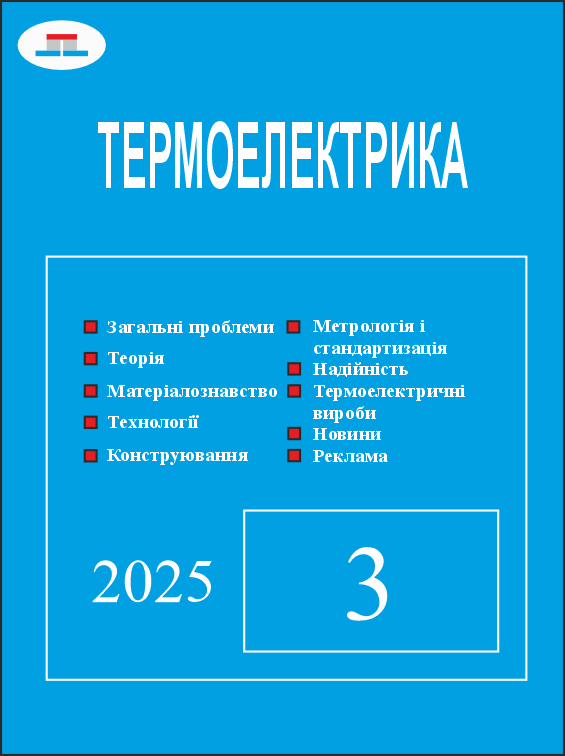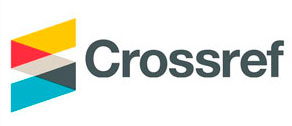Узагальнений параметр і фактор сумісності термоелектричного N-SixGe1-x
DOI:
https://doi.org/10.63527/1607-8829-2025-3-37-44Анотація
Досліджена залежність максимального показника якості (ZT)max сплаву SixGe1-x від узагальненого параметра матеріалу B*. Для розрахунку значень B* використана формула, що містить величини ширини забороненої зони, роздільної електропроводності, масштабованого параметра і решеткової теплопровідності: B*≅7.755·10-4Eg kL-1. Ця формула виведена з об'єднань відомих з літератури формул, що підключають термоелектричні параметри - рухливість, ефективну масу і збільшену рухливість носіїв заряду. У цю формулу вже не входять ефективна маса, рухливість і температура - ці параметри замінені на загальну електропровідність і коефіцієнт Зеебека. Побудована залежність (ZT)max - B*. Розглянувши узагальнений параметр, можна приблизно оцінити максимальне значення показника якості практично для будь-якої термоелектрики.
Визначення коефіцієнта сумісності SixGe1-x. Показана можливість створення сегментних термогенераторів на основі даного матеріалу в поєднанні з YbMg1.8Zn0.05Bi1.98, CuAl0.8Fe0.2O2 і Cu1.98S.
Посилання
1. Rosi F.D. (1968). Thermoelectricity and thermoelectric power generation. Solid State Electronics, 11(9), 849-868.
2. de Winter F. (1972). Xenon-filled silicon germanium thermoelectric generators. JPL Technical Review, 2(3), 22-31.
3. Cook B. (2022). Silicon-germanoim: The legacy lives on. Energies 15(8), 2957.
4. Barbakadze K., Bokuchava G., Isakadze Z. (2022). High temperature thermoelewctricgenrator based on SiGe alloy. Sci J LEPL – Agmashenebeli National Defence Academy of Georgia, 47-50.
5. Schwinge C., Kühnel K., Emara J. (2022). Optimization of LPCVD phosphorous-doped Si Ge thin films for CMOS-compatible thermoelectric applications. Applied Physics Letters, 120(3): 031903.
6. Big-Alabo A. (2021). Finite element modeling and optimization of Ge/SiGe super lattice based thermoelectric generators. Applied Science, 3(2), 189.
7. JangK., Kim Y., Park J., Yi J. (2019). Electrical and structural characteristics of excimer laser-crystallized polycrystalline Si1-xGex thin-film transistors. Materials, 12(11), 1739.
8. Murata H., Nozawa K., Suzuki T. (2022). Si1-xGex anode synthesis on plastic films for flexible rechargeable batteries. Scientific Reports, 12, 13779.
9. Idda A., Ayat L., Dahbi N. (2019) Improving the performance of hydrogenated amorphous silicon solar cell using a-SiGe:H alloy. Ovonic Research, 15(5): 271-278.
10. Singh A.K., Kumar M., Kumar D. (2020). Heterostructure silicon and germanium alloy based thin film solar cell efficiency analysis. Engineering and Manufacturing, 10(2), 29-40.
11. Aberl J., Brehm M., Fromherz T. (2019). SiGe quantum well infrared photo detectors on strained-silicon-on-insulator. Optics Express, 27(22), 32009.
12. Chiang P.T., Hu Sh.M., Yen W.T. (2023). A study of iron-doped SiGe growth for thermoelectric applications. Alloys and Compounds, 967, 171700.
13. Ahmad S., Singh A. (2024). Dopant dependent microstructure of hot-pressed SiGe alloys and its implications on thermoelectric properties. Physica B: Condensed Matter, 674, 415534.
14. Liu W., Zhou J., Jie Q. (2016). New insight into the material parameter B to understand the enhanced thermoelectric performance of Mg2Sn1-x-yGexSby. Energy Environmental Science, 9(2), 530-539.
15. Liu W., Han Z., Ji J. (2023). Uplimit (ZT)max and effective merit parameter B* of thermoelectric semiconductors. Materials Today Physics, 31, 100989.
16. Bokuchava G., Nakhutsrishvili I., Barbakadze K. (2023). SixGe1-x thermoelectric: determination of electronic quality factor, universal electrical conductivity, effective mass, mobility of charge carriers and preparation of monolithic module based on Si0.7Ge0.3 alloy. Fundamental Research and Application of Physical Science, 3, 113-126.
17. Snyder G.J., Caillat T. (2003). Using the compatibility factor to design high efficiency segmented thermoelectric generators. Materials Research Society Proceedings, 793, 37.
18. Snyder G.J. (2004). Application of the compatibility factor to the design of segmented and cascaded thermoelectric generators. Applied Physics Letters, 84(13), 2436.
19. Lobato C.N., Esposito V., Pryds N., Christensen D.V. (2024). How efficient are thermoelectric materials? – An assessment of state-of-the-art individual and segmented thermoelectric materials. Materialstoday-Energy, 43, 101564.
20. Koike S., Yanagisawa R., Jalabert L. (2024). Planar-type SiGe thermoelectric generator with double cavity structure. Applied Physics Letters, 124(12), 123902.
21. Nurachman A., Permata S., Idogho Ch. (2025). Compatibility in thermoelectric material synthesis and thermal transport. Unconventional Resources, 7, 100198.
22. Christian I., Abah E.O., Abel J.E. (2025). Compatibility study of synthesized materials for thermal transport in thermoelectric power generation. Innovation Science and Engineering, 4(1), 2158-7205.
23. Zhao L., Fei F.Y., Wang G. (2017) Improvement of thermoelectric properties and their correlations with electron effective mass in Cu1.98SxSe1-x. Scientific Reports, 7, 40436.
24. Yang K.-I., Li X., Jiang Y. (2025). General screening rules and segmented optimization strategy for efficient thermoelectric devices validated by Mg3(Sb,Bi)2/Bi0.5Sb1.5Te3-GeTe module. Advanced Science, 5, e2502832.
25. Snyder G.J., Pereyra A., Gurunathan R. (2022). Effective mass from Seebeck coefficient. Advanced Functional Materials, 32(20), 2112772.
26. Namiki H., Nagata K., Kobayashi M. (2022) Relationship between the density of states effective mass and carrier concentration of thermoelectric phosphide Ag6Ge10P12 with strong mechanical robustness. Materials Today Sustainability, 18, 100116.
27. Gibbs Z.M., Kim H.S., Wang H., Snyder G.J. (2015). Band gap estimation from temperature dependent Seebeck measurement - Deviations from the 2e|S|maxTmax relation. Applied Physics Letters, 106(2), 022112.
28. Zhang X., Bu Z., Shi X. (2020). Electronic quality factor for thermoelectric. Science Advances, 6, eabc0726.
29. Wei S., Qin N., Wu G. (2024). Thermoelectric properties of Zn-doped YbMg1.85−xZnxBi1.98. Materials, 17(5), 973.
30. Feng Y., Joo J.H., Han G., Lu N. (2023). The effects of Fe addition for enhanced thermoelectric performance in p-type CuAlO2. Engineered Science, 22, 822.




